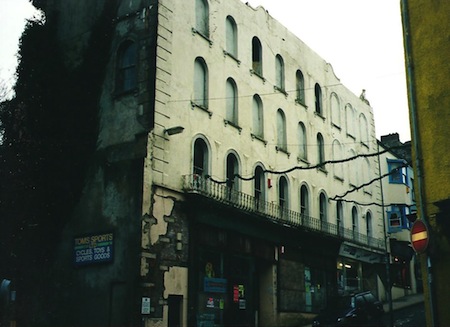Commerce House
Page added 22nd March 2016

Statue on top of Commerce House
Courtesy of Gareth Roberts
The bottom of Market Street, Haverfordwest has for decades presented problems, the biggest element of these being Commerce House.
Dating back to 1850 the property was designed and built by Thomas Randle, an ancestor of the late Gerald Oliver, who arrived in Haverfordwest with the new railway as an assistant to Isambard Kingdom Brunel.
A descendant of Randle was the Dawkins of the partnership that started the store, initially known as Greenish and Dawkins. It became the largest department store in west Wales with its upper floors used as dormitories for staff who stayed in the property for the greater part of the week.
By 1894, the importance and success of the business led to the two statues jointly representing commerce being placed on the top of the building.
Individually, they represented ‘Importation’ and ‘Exportation’ and were created by Butcher and Axtell of Camberwell Road, London who were also responsible for the Albert Memorial in Kensington Gardens.
Born in 1871, John Nicholas did an apprenticeship with a draper in High Street Haverfordwest before trying areas further afield. He worked in Swansea, Cardiff, Chicago and other American cities having management status in a business in South Dakota.
In 1908 he returned to the UK and opened a business in Somerset. Finding the pull of his home town too great to resist he purchased most of the shares (it had become incorporated into a company in 1906) in Commerce House in 1923, becoming sole owner in 1926.
By 1936, Nicholas had taken on a partner, Norman Evans, and had expanded the interests of the store to include furniture and ladies hairdressing.
In 1939 came the Second World War. Although Pembrokeshire’s importance as a base from where it was ideal to launch air attacks on U Boats didn’t materialise until later, the immediate fear was in respect of its huge length of undefended coastline. As such, troops were rushed into the county in large numbers with the main urgent requirement being for properties in which to billet them.
On the 19th October, just six weeks into the war, John Nicholas was approached by the requisitioning arm of the military and told that Commerce House was required. Under the impression that it was only the dormitory areas on the upper floors that were required, Nicholas began trying to reschedule the business. He was told days later that the entire property was required immediately and that it could be done compulsorily or voluntarily. He and his partner tried to effect a ‘closing down sale’ but even as they were trying to re-price every item and advertise a mega sale, the military began moving in on the 25th October.
With every building of any size (which they might have used as alternative premises) already taken by the military, they decided to sell everything by bulk tender which realised £625 on stock that would normally have sold for £3,000. Following this it was decided that the only option remaining was to file for bankruptcy.
The building was occupied by part of the Welch Regiment which had been a TA unit and was being integrated into the regular army.
The Compensation (Defence) Act was particularly harsh in not recognising goodwill or profit and a complex case arose whereby a property already the subject of a voluntary liquidation was involved. Both the business and the property never really recovered from this.
A sports shop existed for years in part of the property after the war, before it was closed and the whole structure began swiftly to deteriorate. Finally, fearing that the huge building would collapse, a firm was brought in to initially stabilize it before demolishing it.

Final throes
Eight scaffolders worked 12 hours per day for three weeks to erect the scaffolding structure which consisted of 5 miles of scaffolding poles weighing 32 tons together with 5000 fittings, all stabilised by 3500 concrete blocks and resting on 200 metres of railway sleepers. All of this meant that Market Street was closed totally for over eighteen months during which the building was demolished.
The new building, mostly comprising flats, that replaces the old one stretches over the old medieval crypt, another aspect of the town’s heritage which has sadly been lost, despite the Local Authority suggesting that this wouldn’t happen.